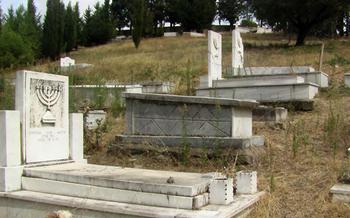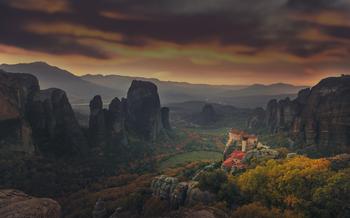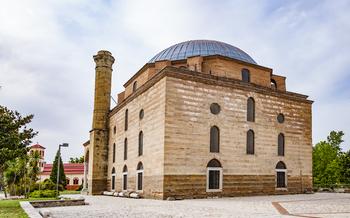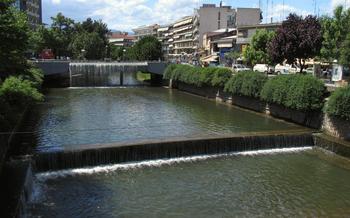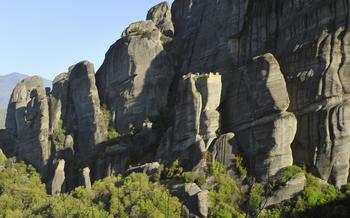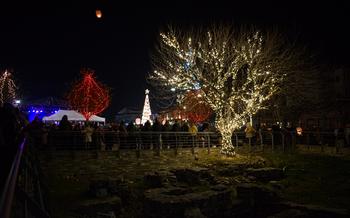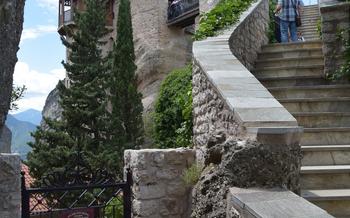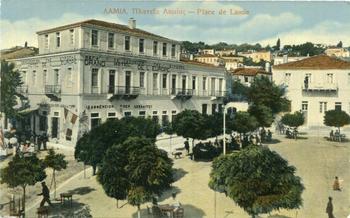
Metéora Monasteries
- The Metéora Monasteries: Atop Rock Formations
- History and Origins
- Stunning Natural Beauty
- Visiting the Monasteries
- Accessibility and Transportation
- Operating Hours and Admission Fees
- Dress Code and Etiquette
- Guided Tours and Self-Exploration
- Monastery of Great Meteoron: A Majestic Abode Amidst the Clouds
- Monastery of Varlaam
- Monastery of Roussanou
- Monastery of St. Nicholas Anapausas
- Monastery of St. Stephen
- Hiking and Trekking
- Photography Opportunities
- Religious and Spiritual Significance
- Local Cuisine and Hospitality
- Festivals and Events
- Insider Tip: Plan Your Visit
The Metéora Monasteries: Atop Rock Formations
Historical Significance The Metéora Monasteries are a complex of six Eastern Orthodox monasteries perched atop towering rock formations in Central Greece. These monasteries have a rich and intriguing history, dating back to the 14th century when hermits and monks sought refuge in these isolated and inaccessible locations to escape religious persecution and dedicate their lives to prayer and contemplation.
Architectural Marvels The monasteries are architectural wonders, constructed using innovative techniques and materials. They feature intricate frescoes, beautiful wood carvings, and impressive stonework, showcasing the artistic and engineering skills of the builders. Each monastery has its own unique architectural style, reflecting the different periods in which they were constructed.
UNESCO World Heritage Site The Metéora Monasteries were designated a UNESCO World Heritage Site in 1988, recognizing their outstanding universal value. This prestigious designation highlights the monasteries' cultural, historical, and architectural significance and attracts visitors from around the world who come to marvel at these awe-inspiring structures.
Breathtaking Views The monasteries offer breathtaking views of the surrounding landscape. Perched atop towering rock formations, they provide panoramic vistas of the Thessalian Plain, the Pindus Mountains, and the picturesque villages nestled below. The stunning scenery and the monasteries' unique location create a sense of awe and wonder, leaving visitors with unforgettable memories.
History and Origins
The Metéora Monasteries, with their awe-inspiring presence atop towering rock formations, have a rich and fascinating history. Their origins can be traced back to the 14th century when Eastern Orthodox monks, seeking isolation and spiritual enlightenment, found refuge in these seemingly inaccessible cliffs. These monks, driven by their devotion, established monastic communities in these remote locations, creating a unique and enduring legacy.
Over time, these communities flourished, attracting followers and pilgrims from across the region. The monasteries became centers of religious and cultural life, preserving ancient traditions and contributing to the development of Byzantine art and architecture. Despite the challenges of living in such isolated and harsh conditions, the monks persevered, building and expanding their monasteries, creating the architectural marvels that we see today.
The monasteries' strategic location also played a role in their survival. Perched high above the surrounding landscape, they were relatively safe from attack and invasion. This allowed them to endure through centuries of political and religious turmoil, preserving their unique way of life and their invaluable contributions to Greek history and culture.
The preservation and restoration efforts undertaken in recent decades have ensured that the Metéora Monasteries continue to stand as testaments to the ingenuity and faith of their founders. Visitors can now marvel at these architectural wonders, immerse themselves in their rich history, and experience the spiritual atmosphere that has permeated these sacred spaces for centuries.
Stunning Natural Beauty
The Metéora Monasteries are renowned for their breathtaking natural beauty. The unique rock formations, towering cliffs, and panoramic vistas create a landscape that is both awe-inspiring and serene. The monasteries themselves seem to blend seamlessly into their surroundings, as if they were naturally formed from the rocks themselves.
The towering cliffs provide a dramatic backdrop to the monasteries, creating a sense of wonder and amazement. The sheer size and height of the cliffs are enough to take your breath away, and the views from the monasteries are simply stunning. You can see for miles in every direction, taking in the vastness of the surrounding landscape.
The panoramic vistas from the monasteries offer a unique perspective on the surrounding area. You can see the lush forests, the winding rivers, and the distant mountains. The views are especially breathtaking at sunset, when the sky is painted with vibrant colors that reflect off the cliffs and monasteries.
The monasteries are also surrounded by a network of scenic hiking trails. These trails wind through the forests and along the cliffs, offering hikers the opportunity to explore the natural beauty of the area up close. Along the way, you can discover hidden monasteries, cascading waterfalls, and secluded viewpoints.
Visiting the Monasteries
Visiting the Metéora Monasteries is an unforgettable experience that combines history, nature, and spirituality. To make the most of your visit, plan your itinerary carefully, considering accessibility, transportation, operating hours, and admission fees.
Accessibility and Transportation
The Metéora Monasteries are located in a remote area of central Greece, about 350 kilometers (220 miles) northwest of Athens. The easiest way to reach them is by car, as there is no direct public transportation from major cities. Several tour operators offer day trips from Athens or Thessaloniki, which include transportation and guided tours of the monasteries.
Operating Hours and Admission Fees
The monasteries are open to the public daily, but their operating hours may vary depending on the season. Generally, they are open from morning until evening, with a break during the midday heat. Admission fees are typically charged, and discounts are often available for students and seniors.
Dress Code and Etiquette
When visiting the monasteries, it is important to dress respectfully. Shorts, tank tops, and revealing clothing are not allowed. Women should cover their shoulders and knees, and men should wear long pants. Photography is permitted in most areas of the monasteries, but it is important to be respectful of the monks and other visitors.
Guided Tours and Self-Exploration
Guided tours are available at most of the monasteries and provide an excellent way to learn about their history and architecture. However, it is also possible to explore the monasteries on your own, allowing you to set your own pace and focus on the areas that interest you most.
Monastery of Great Meteoron: A Majestic Abode Amidst the Clouds
Perched atop a towering rock formation that seemingly pierces the heavens, the Monastery of Great Meteoron stands as the largest and oldest monastery among the Metéora complex. Established in the 14th century by the venerable Saint Athanasios the Meteorite, this architectural marvel boasts an impressive and storied past.
With its intricate frescoes adorning the walls of its grand halls and chapels, the Monastery of Great Meteoron transports visitors to a bygone era, where faith and devotion intertwined with the raw power of nature. The monastery's strategic location offers unparalleled panoramic views of the surrounding landscape, inviting visitors to revel in the breathtaking beauty of the Thessalian plains and the distant Pindus Mountains.
A testament to the enduring spirit of Orthodox monasticism, the Monastery of Great Meteoron has withstood the test of time, weathering centuries of political and religious turmoil. It remains a beacon of spirituality, attracting pilgrims and visitors from around the world who seek solace, inspiration, and a glimpse into the rich history of Eastern Orthodox Christianity.
Monastery of Varlaam
The Monastery of Varlaam, the second largest of the Metéora monasteries, stands proudly atop a massive rock formation, offering breathtaking views of the surrounding landscape. Founded in the 16th century, it boasts remarkable architecture and exquisite frescoes that adorn its interior walls. Visitors can marvel at the intricate wood carvings that embellish the monastery's doors and furnishings, adding to its unique charm. The monastery of Varlaam is a testament to the artistic prowess and spiritual devotion of its founders, inviting visitors to immerse themselves in its rich history and spiritual significance.
Monastery of Roussanou
Perched atop a towering cliff, the Monastery of Roussanou is a breathtaking sight. Founded in the 16th century, this monastery is known for its intricate frescoes and stunning views of the surrounding valley.
Impressive Architecture and Frescoes: The Monastery of Roussanou boasts impressive architecture, featuring a combination of Byzantine and post-Byzantine styles. Its beautiful frescoes are a testament to the artistic prowess of the monks who once resided here.
Breathtaking Views: The monastery offers breathtaking views of the surrounding landscape, allowing visitors to witness the beauty of the Meteora region. From its vantage point, visitors can gaze upon the towering cliffs, lush valleys, and distant mountains that define this unique region.
A Place of Tranquility: The Monastery of Roussanou exudes a sense of tranquility and serenity, inviting visitors to immerse themselves in the spiritual atmosphere of this holy site. Whether seeking solace or simply admiring its beauty, the monastery provides a peaceful retreat for all who visit.
Monastery of St. Nicholas Anapausas
The Monastery of St. Nicholas Anapausas is another architectural marvel that deserves your attention. Founded in the 14th century, this monastery is perched atop a rock, offrant breathtaking panoramic views of the surrounding area. The well-preserved frescoes depicting religious scenes are a testament to the artistic prowess of the monks who once resided here. Take some time to explore the monastery's interior and admire the intricate details that adorn its walls and ceilings. The spiritual atmosphere that permeates the air will provide you with a sense of tranquility and peace.
Monastery of St. Stephen
Perched atop a steep cliff, the Monastery of St. Stephen is a testament to the enduring faith and architectural prowess of the Eastern Orthodox monks who settled in Meteora. Founded in the 11th century, this monastery is one of the oldest and most historically significant in the region.
Renowned for its impressive architecture, the Monastery of St. Stephen features intricate stonework and beautiful frescoes that adorn its interior walls. Visitors can marvel at the well-preserved murals depicting scenes from the Bible and the lives of the saints, which offer a glimpse into the rich spiritual heritage of the monastery.
In addition to its architectural and artistic treasures, the Monastery of St. Stephen also offers breathtaking views of the surrounding mountains and valleys. From the monastery's vantage point, visitors can enjoy panoramic vistas that stretch for miles, taking in the stunning natural beauty of the Meteora region.
Whether you are drawn to its historical significance, architectural marvels, or stunning scenery, the Monastery of St. Stephen is a must-visit destination for anyone exploring the Meteora Monasteries.
Hiking and Trekking
In addition to the monasteries themselves, the Metéora region offers a network of scenic hiking trails that allow visitors to explore the surrounding natural beauty. These trails wind through forests, past hidden monasteries, and offer breathtaking views of the rock formations and the surrounding countryside. Whether you're an experienced hiker or simply looking for a leisurely stroll, there's a trail to suit your needs and abilities.
One of the most popular hiking trails is the one that leads to the Monastery of Great Meteoron, the largest and most famous of the monasteries. This trail takes you through a dense forest and offers stunning views of the monastery perched on top of a towering rock formation. Another popular trail leads to the Monastery of Varlaam, the second largest monastery. This trail is slightly more challenging, but it offers equally stunning views of the monastery and the surrounding landscape.
For those looking for a more challenging hike, there are several trails that lead to the more remote monasteries, such as the Monastery of St. Nicholas Anapausas and the Monastery of St. Stephen. These trails are more strenuous, but they offer a unique opportunity to explore the hidden gems of the Metéora region.
No matter which trail you choose, be sure to wear comfortable shoes and bring plenty of water, as there are no water sources along the trails. And don't forget your camera, as you'll have plenty of opportunities to capture stunning photos of the monasteries and the surrounding landscape.
Photography Opportunities
The Metéora Monasteries offer a plethora of opportunities for photography enthusiasts. With their unique rock formations, towering cliffs, and panoramic vistas, these monasteries provide a picturesque backdrop for capturing stunning images. Photographers can capture the monasteries perched precariously on the cliffs, creating a dramatic contrast between the man-made structures and the natural landscape. The panoramic views of the surrounding area offer breathtaking photo opportunities, allowing visitors to capture the vastness and beauty of the region. The unique architecture of each monastery, with its intricate frescoes and wood carvings, provides another subject for photography. Visitors can explore the monasteries' interiors and exteriors, capturing details that showcase their historical and artistic significance. Whether you're a professional photographer or simply enjoy taking pictures, the Metéora Monasteries offer an unforgettable experience for capturing stunning and memorable images.
Religious and Spiritual Significance
The Metéora Monasteries hold immense religious and spiritual significance for Orthodox Christians worldwide. They serve as a pilgrimage site, attracting countless believers who come to pay homage, seek spiritual guidance, and immerse themselves in the monasteries' rich history and traditions. Visitors can explore the monasteries' chapels, marvel at the intricate religious iconography, and attend religious services or ceremonies, experiencing the profound spiritual atmosphere that permeates these sacred spaces. Whether you're a devout Orthodox Christian seeking spiritual renewal or simply curious about the role of religion in Greek culture, the Metéora Monasteries offer a unique and enriching experience.
Local Cuisine and Hospitality
Experience the authentic flavors of Greece while visiting Metéora. Indulge in traditional Greek cuisine at local tavernas and restaurants, savoring dishes such as moussaka, pastitsio, and fresh seafood. Enjoy the warm hospitality of the locals who are always ready to welcome visitors with open arms. Support local businesses by purchasing souvenirs and handicrafts from the shops and stalls in the nearby villages. Embrace the opportunity to connect with the local community and learn about their rich cultural heritage.
Festivals and Events
In Larissa, the spirit of celebration is vibrant, and the city's bustling streets come alive with energy during various festivals and events. These festivities showcase the rich cultural heritage, traditions, and hospitality of the Greek people.
One of the highlights is the Larissa Festival, held annually in July and August. This lively event features a multitude of cultural performances, concerts, art exhibitions, and traditional dancing that will immerse you in the vibrant Greek culture.
For those seeking a religious experience, the Feast of Saint Achilles, celebrated on May 15th, is a significant event in Larissa. Devout pilgrims and locals gather at the Church of Saint Achilles to honor the city's patron saint with processions, prayers, and a festive atmosphere.
If you happen to be in Larissa during the Easter period, you will witness the deeply rooted Orthodox traditions and customs. The city transforms with elaborate decorations, and the air is filled with the scent of incense and freshly baked bread. Experience the solemn processions, attend church services, and partake in the joyous Easter feast with locals.
These festivals and events provide a unique opportunity to connect with the local community, immerse yourself in Greek culture, and create lasting memories in Larissa.
Insider Tip: Plan Your Visit
To make the most of your visit to the Metéora Monasteries, consider these insider tips:
-
Avoid the crowds: The monasteries are most popular during the summer months, so if you want to avoid the crowds, plan your visit during the shoulder season (April-May or September-October).
-
Arrive early: If you want to avoid long lines, arrive at the monasteries early in the morning. Most monasteries open around 9 am, and the earlier you arrive, the fewer people you'll have to contend with.
-
Wear comfortable shoes: You'll be doing a lot of walking and hiking, so make sure to wear comfortable shoes. The paths to the monasteries can be steep and uneven, so good footwear is essential.
-
Bring your camera: The Metéora Monasteries are incredibly photogenic, so don't forget to bring your camera to capture the stunning views. You'll want to capture the monasteries perched on cliffs, the panoramic views of the surrounding area, and the unique rock formations.
